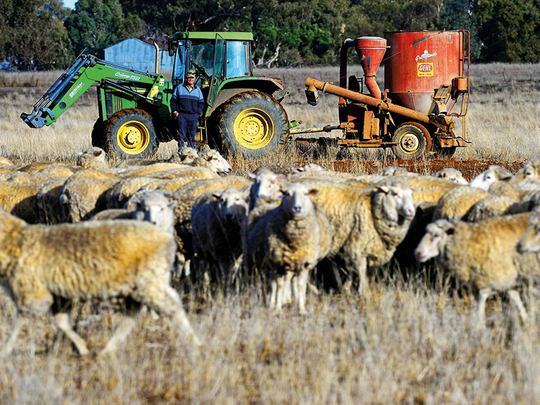
Murrurundi: A crippling drought is ravaging vast tracts of Australia’s pastoral heartlands, decimating herds and putting desperate farmers under intense financial and emotional strain, with little relief in sight.
While the country is no stranger to “big drys” and its people have a reputation for being resilient, the extreme conditions across swathes of the country’s east are the worst in more than 50 years.
A smattering of rain earlier this week did little to ease one of the driest starts to the year on record, turning pastures to dust and destroying huge areas of grazing and crop lands.
With no feed, farmers have been forced to ship in grain or hay from other parts of the country to keep sheep and cattle alive, spending thousands of extra dollars a week just to stay afloat.
Some exhausted graziers spend hours each day hand-feeding their stock, because the ground is too dry for grass to grow. Others have been forced to shoot starving cattle. “They are shooting their stock because they don’t want them to suffer and just can’t afford to feed them anymore,” Tash Johnston, co-founder of charity Drought Angels, told AFP.
Farmers have also had to ration water for their families and their herds because the dams on their properties are dry or nearly empty.
Many face the prospect of abandoning their homes altogether — some after being on the land for generations.
- Greg Stones | Farmer
It is a scenario repeated across New South Wales state, where agriculture contributes more than Australian $15 billion (US$11 billion) to the state’s economy annually, employing more than 77,000 people.
Authorities on Wednesday officially declared the entire state in drought.
Conditions are similarly dire in Queensland to the north, where the state government says nearly 60 per cent of land is suffering drought conditions.
“This would be the first time in two generations, back to the 1930s, that we haven’t got a crop up in the autumn or winter time,” Greg Stones, who runs a small farm of cattle, sheep, grain and crops near drought-hit Gunnedah, a five-hour drive north of Sydney, told AFP. “The land is too dry... We’ve put cattle on the highway (near the farm) for the first time in my life (so) they get a bit of rough grass.”
With farmers facing ruin, the national government stepped in last weekend, pledging a Australian $190 million package of immediate relief measures. It includes two lump sum payments worth up to Aus$12,000 per household, and changes to an assets test to grant support to thousands more farmers.
There was also cash for counselling and mental health services, with drought-related stress and even suicide a mounting concern, compounded by the isolation many feel on their remote properties.
“We are the land of droughts and flooding rains. We recognise that. It’s a very volatile and often capricious climate and Australian farmers are resilient, they plan for drought, they are good managers but it can become really overwhelming,” said Prime Minister Malcolm Turnbull.
“They understand drought is part of the Australian climate and they manage for it, but this drought is longer and more widespread than any drought we’ve seen in over 50 years so that’s why we’ve got to provide additional support.”












